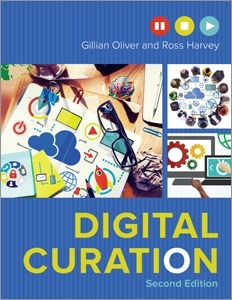Primary tabs
You don't need to be an ALA Member to purchase from the ALA Store, but you'll be asked to create an online account/profile during checkout to proceed. This Web Account is for both Members and non-Members. Note that your ALA Member discount will be applied at the final step of the checkout process.
If you are Tax-Exempt, please verify that your account is currently set up as exempt before placing your order, as our new fulfillment center will need current documentation. Learn how to verify here.
- Description
- Table of Contents
- About the authors
- Reviews
This book is available in e-book format for libraries and individuals through aggregators and other distributors—ask your current vendor or contact us for more information. Examination copies are available for instructors who are interested in adopting this title for course use.
As an in-depth explanation of the entire digital curation lifecycle, from creation to appraisal to preservation to organization/access to transformation, the first edition of this text set a benchmark for both thoroughness and clarity. Boasting the expert guidance of international authorities Oliver and Harvey, this revamped and expanded edition widens the scope to address continuing developments in the strategies, technological approaches, and activities that are part of this rapidly changing field. In addition to current practitioners, those pursuing a career as librarian, archivist, or records manager will find this definitive survey invaluable. Filled with up-to-date best practices, it covers such important topics as
- the scope and incentives of digital curation, detailing Digital Curation Centre's (DCC) lifecycle model as well as the Data Curation Continuum;
- key requirements for digital curation, from description and representation to planning and collaboration;
- the value and utility of metadata;
- considering the needs of producers and consumers when creating an appraisal and selection policy for digital objects;
- the paradigm shift by institutions towards cloud computing and its impact on costs, storage, and other key aspects of digital curation;
- the quality and security of data;
- new and emerging data curation resources, including innovative digital repository software and digital forensics tools;
- mechanisms for sharing and reusing data, with expanded sections on open access, open data, and open standards initiatives; and
- processes to ensure that data are preserved and remain usable over time.
Useful as both a teaching text and day-to-day working guide, this book outlines the essential concepts and techniques that are crucial to preserving the longevity of digital resources.
List of Figures
List of Abbreviations
Preface
Acknowledgments
Part I: Digital Curation: Scope and Incentives
1 Introduction
2 The Changing Landscape
3 Conceptual Models
4 Defining Data
Part II: Key Requirements for Digital Curation
5 Curation and Curators
6 Description and Representation Information
7 Preservation Planning and Policy
8 Sharing Knowledge and Collaborating
Part III: The Digital Curation Lifecycle in Action
9 Designing Data
10 Creating Data
11 Deciding What Data to Keep
12 Ingesting Data
13 Preserving Data
14 Storing Data
15 Using and Reusing Data
About the Authors
Index
Gillian Oliver
Dr. Gillian Oliver is Associate Professor of Information Management at Monash University in Australia. Previously she led teaching and research into archives and records at Victoria University of Wellington and the Open Polytechnic of New Zealand. Her research interests focus on data cultures, including the information cultures of workplaces and issues relating to the continuity of digital information, particularly in development contexts. She is the author of four books and is co-editor-in-chief of the journal Archival Science.
Ross Harvey
Dr. Ross Harvey is Editor of the Australian Library Journal and Adjunct Professor in Information Management in the School of Business IT and Logistics, RMIT University, Melbourne, Australia. He has held academic positions at universities in Australia, Singapore, and the United States, most recently in the Graduate School of Library and Information Science at Simmons College, Boston. His research and teaching interests focus on the stewardship of digital materials in libraries and archives, particularly on their preservation, and on the history of the book. He has extensive experience in research projects in Australia and the United Kingdom, including the Humanities Advanced Technology and Information Institute at the University of Glasgow and the Digital Curation Centre. He has published widely in the fields of bibliographic organization, library education, the preservation of library and archival material, and newspaper history. His most recent books are The Preservation Management Handbook, co-authored with M. Mahard, and the second edition of Preserving Digital Materials.
"Oliver and Harvey artfully summarize a potentially overwhelming mass of information. Each chapter includes lists, charts, and hyperlinks, as well as ample margins to facilitate note-taking … the content itself is divided into manageable, memorable segments."
— ARBA
”Clearly written and heavily annotated, this volume is an authoritative exploration of a complex topic ... An essential text for anyone interested in digital curation."
— Library Journal
”There is truly a wealth of information on every page … The text provides precise and up-to-date workflows and terminology, as well as describing best practices in digital curation. The best overall feature of this book is it is designed as a reference source that can be used within any phase of a digital project."
— Technical Services Quarterly
”This second edition provides a substantive update to Harvey’s original that will continue to act as both an introduction to an emerging field and a valuable reference resource for established digital curators."
— Technicalities
”This is an easy-to-use compendium of best practices for any constrained digital repository, regardless of its identification as a formal archive or not. In fact, libraries that skate on the outside boundaries of archival processes for their special collections will benefit from this book in its practical approach to curating all manner of digital data, not just that from the humanities and social sciences."
— Catholic Library World



